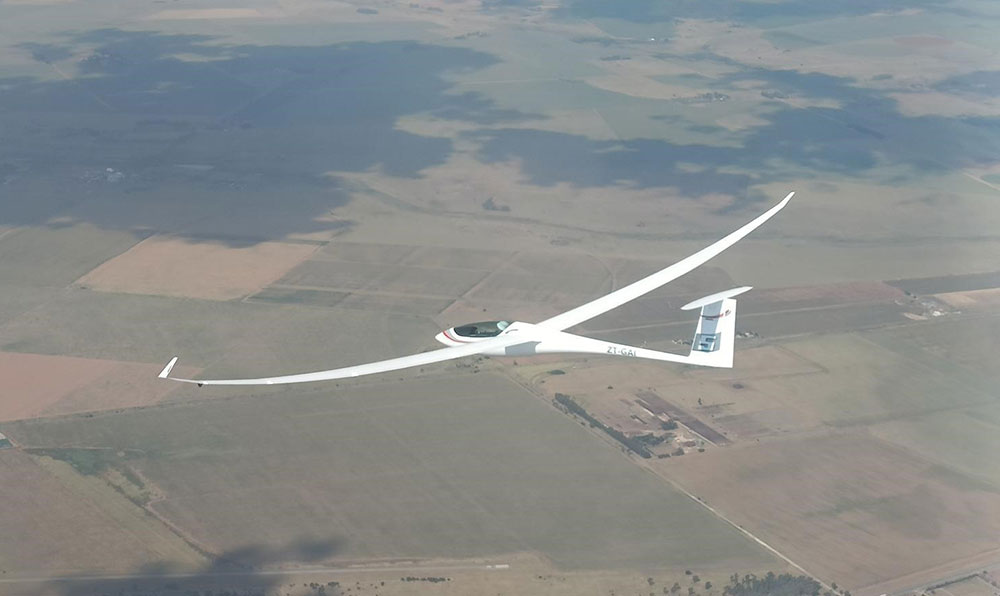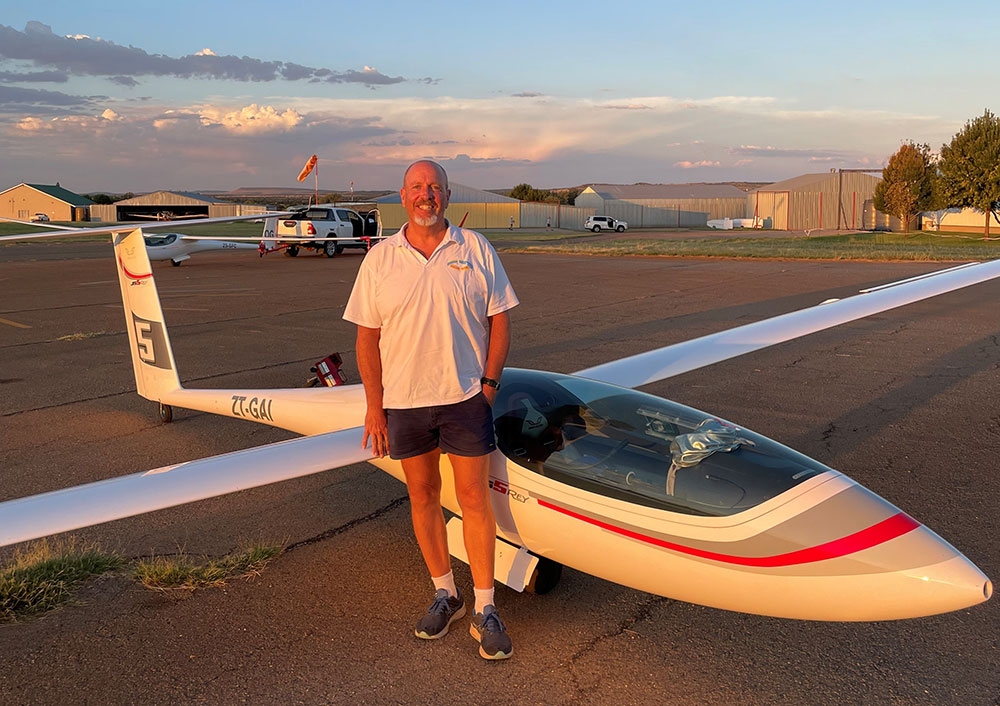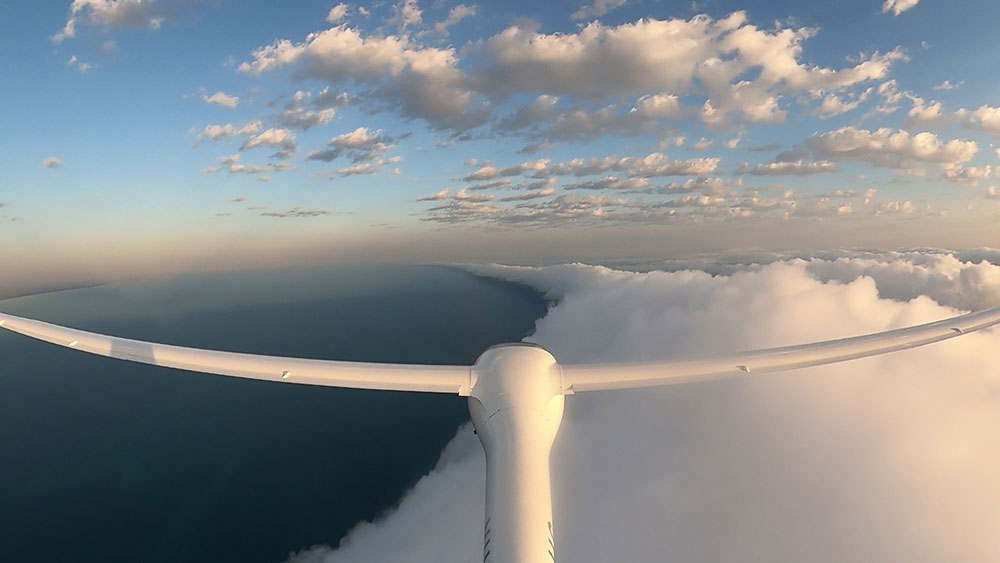
By Lumpy Paterson
Tocumwal Soaring Centre
In March this year I made my second visit to the Jonkers Sailplane Factory in Potchefstroom South Africa to catch up with the JS team. My first trip was back in June of 2017 to look over the development of the 18m version of the JS3. I had one on order and was keen to see the inner workings and take the opportunity to fly one of the prototypes.
We took the opportunity with Uys Jonker and the South African Team coming to Australia for the World Gliding Championships last year, to host an information seminar on the newly built JS3 RES sailplanes at Tocumwal Soaring Centre. Uys was keen to get as much practical information to the Australian gliding community about their exciting new developments with self-launching electric sailplanes, as a large number are being delivered into the country. It was during this visit we had some discussions around the new JS5 which was about to start being produced back in the factory and we hatched a plan for me to pay them a visit once the prototype was ready to go.
On both visits to the factory, the Jonkers team made me feel very welcome and provided access to all areas of the production line, which was very enlightening. Building stuff is not my strong suit, but I like to understand and have the knowledge of how it’s been done. As I discovered on the first visit, there’s an opportunity to provide customer feedback to the design team, requesting and or suggesting changes to the layout in the cockpit area to enhance the pilot experience.

Production Line
The whole production line was a hive of activity and in particular the final stage assembly area for the JS3 RES, with glider rego’s from all over the world getting tested and ready to be shipped out. I believe that nine out of every ten JS3s going out the door are RES, so the concept looks to be very popular.
Up Close
The purpose of the visit was to get up close and personal with their new glider in the fleet, the Open Class JS5, which interestingly was designed just prior to Covid. It’s evident that all glider manufacturers have their own signatures with their designs and for the most part, the fuselages stay common. However, emphasis on the wing profiles is noticeable. The JS5 certainly displays the Jonkers wing with all the kinks in the right places and maintaining the thin profile.
At first glance, the glider has beautiful lines and looks smooth in every aspect. The JS2 and JS5 share the same fuselage and power plant. The wingspan on the JS5 is 24 metres, which I feel is a great compromise between long wing performance and the desired handling of the 18 metre span ships. I’ve owned and or flown quite a few open class gliders including the EB29R, Nimbus 4T, ASH25 and the Quintus M which all have mixed wing spans and handling characteristics. The Quintus and JS5 both handle very nicely with respect to their controllability and manoeuvring as you’d expect with the smaller span, being able to roll from 45° to 45° keeping the yaw string well centred and certainly don’t suffer as much as the larger span gliders in the higher cruise speeds.
The cockpit area is very comfortable and accommodating, and a little bit different posture than that of the JS3. The canopy area is more like the JS1 which provides great visibility with the lower canopy rail passing through your arm and I guess is more conventional, whereas your shoulder sits below the rail in the JS3. This was a conscious change in the design to assist pilots with getting in and out of the glider. The instrument panel has been moved closer to the pilot by a few centimetres and the sunhood which sits above has been extended, both nice touches. The fuselage is slightly narrower at your knees than the JS1 to streamline the cockpit area, but has the same shoulder space. The control loads on the stick are very light which is consistent with the newer generation open class gliders, they certainly don’t feel like big gliders and the flap lever is effortless to move. The rudder is always the holding point for these bigger gliders and it's hard to coordinate the feel and loads with that of the stick. However, I feel that the team has got this pretty good. The rudder hinge system is all internal like on the JS3 to minimise drag and the pedal loads are significantly lighter than that of the JS1, which pilots who have flown in 21 metre will appreciate. The retractable steerable tailwheel is a great addition, which assists the ability to self-launch and makes taxiing much more possible.

Three Days Flying
I was fortunate to be able to fly the JS5 for three days while in Potchefstroom with some quite good soaring conditions. As I got more comfortable with the glider, the weather allowed me to fly the JS5 at its max wing loading giving me a real opportunity to evaluate the glider's handling and performance. On this occasion, I was able to share the sky with Oscar Goudriaan in his JS3, enabling us to compare how these gliders ran against each other in favourable conditions. This included a flight of 750kms at 152kph in some good cu filled skies, cruising at 110 to 115 kts and there was very little difference in the performance. This was a welcomed and somewhat surprising outcome as normally the longer wings fall away at the top end of the cruise speed curve. The JS5 wasn’t giving anything away. Knowing that the JS3 is no slouch in LD, later that afternoon we were able to do some slow speed flying with a ninety-kilometre final glide in very still air (45 minutess before sunset) and it was evident to see that the long wings delivered an exceptional glide, even with a few bugs on the wings.

The new JS5 sailplane was an absolute delight, and I feel very privileged to have had the opportunity to fly such a magnificent glider. I’ll be able to see firsthand how they debut at their first World Gliding Championships in Uvalde and I am looking forward to seeing the speeds these gliders will do in the Texas skies.
On the other few days, Attie Jonker kindly offered me his JS3X to fly which was also great fun. The JS3X differs a little from the production version with a larger tailplane (that of the JS3RES) and extended flap area on the inboard side towards the fuselage. I was also able to watch the flight-testing program of the JS2 and see it put through the rigorous flight envelope requirements for EASA certification. I'm not so sure I’d like to be a test pilot after seeing this!
I finished up with five great days of soaring while in South Africa and covered over 2,523km and around 20 hours flying in March. It was a very nice way to wind down our season.
A very big thank you to Uys, Attie, AP and the team for looking after me so well.
Disclaimer: All those who know me, understand that I own 20 something gliders from different manufacturers and I’m not a Jonkers representative, rather a very satisfied customer.
































